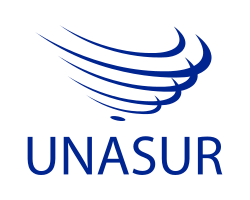Suriname
Suriname (/ˈsjʊərɪnæm/, US also /-nɑːm/, sometimes spelled Surinam), officially known as the Republic of Suriname (Dutch: Republiek Suriname [reːpyˌblik syːriˈnaːmə]), is a country on the northeastern Atlantic coast of South America. It is bordered by the Atlantic Ocean to the north, French Guiana to the east, Guyana to the west and Brazil to the south. At just under 165,000 square kilometers (64,000 square miles), it is the smallest sovereign state in South America.[note 1] Suriname has a population of approximately 575,990,[8][9] most of whom live on the country's north coast, in and around the capital and largest city, Paramaribo.
Republic of Suriname | |
|---|---|
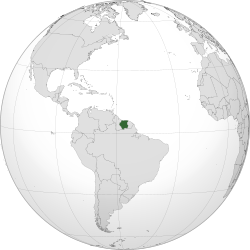 | |
| Capital and largest city | Paramaribo 5°50′N 55°10′W |
| Official languages | Dutch |
| Recognised regional languages | 8 indigenous languages
|
| Other languages | 14 languages
|
| Ethnic groups (2012) | |
| Religion | |
| Demonym(s) | Surinamese |
| Government | Unitary republic |
| Chan Santokhi (VHP) | |
| Ronnie Brunswijk (ABOP) | |
| Legislature | National Assembly |
| Independence | |
| 15 December 1954 | |
• from the Kingdom of the Netherlands | 25 November 1975 |
• current constitution | 30 September 1987 |
| Area | |
• Total | 163,821 km2 (63,252 sq mi) (90th) |
• Water (%) | 1.1 |
| Population | |
• July 2018 estimate | 575,990[8][9] (171st) |
• 2012 census | 541,638[5] |
• Density | 2.9/km2 (7.5/sq mi) (231st) |
| GDP (PPP) | 2019 estimate |
• Total | $9.044 billion[10] |
• Per capita | $15,845[10] |
| GDP (nominal) | 2019 estimate |
• Total | $4.110 billion[10] |
• Per capita | $6,881[10] |
| HDI (2017) | high · 98th |
| Currency | Surinamese dollar (SRD) |
| Time zone | UTC-3 (SRT) |
| Driving side | left |
| Calling code | +597 |
| ISO 3166 code | SR |
| Internet TLD | .sr |
Situated slightly north of the Equator, Suriname is a tropical country dominated by rain forests. Its extensive tree cover is vital to the country's efforts to mitigate climate change and reach carbon neutrality. A developing country with a high level of human development, Suriname's economy is heavily dependent on its abundant natural resources, namely bauxite, gold, petroleum and agricultural products.
Suriname was inhabited as early as the fourth millennium BC by various indigenous peoples, including the Arawaks, Caribs, and Wayana. Europeans arrived in the 16th century, with the Dutch establishing control over much of the country's current territory by the late 17th century. During the Dutch colonial period, Surname was a lucrative source of sugar, its plantation economy driven by African slave labor and, after abolition of slavery in 1863, indentured servants from Asia. In 1954, Suriname became one of the constituent countries of the Kingdom of the Netherlands. On 25 November 1975, Suriname left the Kingdom to become an independent state, nonetheless maintaining close economic, diplomatic, and cultural ties to its former colonizer.
Suriname is considered to be a culturally Caribbean country, and is a member of the Caribbean Community (CARICOM). Suriname is the only sovereign nation outside Europe where Dutch is the official and prevailing language of government, business, media, and education.[12] Sranan Tongo, an English-based creole language, is a widely used lingua franca. As a legacy of centuries of colonialism, the people of Suriname are among the most diverse in the world, spanning a multitude of ethnic, religious, and linguistic groups.
Etymology
The name Suriname may derive from an indigenous people called Surinen, who inhabited the area at the time of European contact.[13] It may also be derived from a corruption of the name "Surryham" which was the name given to the Suriname River by Lord Willoughby in honour of the Earl of Surrey when an English colony was established under a grant from King Charles II.[14][15][16]
British settlers, who founded the first European colony at Marshall's Creek[17] along the Suriname River, spelled the name as "Surinam".
When the territory was taken over by the Dutch, it became part of a group of colonies known as Dutch Guiana. The official spelling of the country's English name was changed from "Surinam" to "Suriname" in January 1978, but "Surinam" can still be found in English; a notable example is Suriname's national airline, Surinam Airways. The older English name is reflected in the English pronunciation, /ˈsjʊərɪnæm, -nɑːm/. In Dutch, the official language of Suriname, the pronunciation is [ˌsyriˈnaːmə], with the main stress on the third syllable and a schwa terminal vowel.
History

Indigenous settlement of Suriname dates back to 3,000 BC. The largest tribes were the Arawak, a nomadic coastal tribe that lived from hunting and fishing. They were the first inhabitants in the area. The Carib also settled in the area and conquered the Arawak by using their superior sailing ships. They settled in Galibi (Kupali Yumï, meaning "tree of the forefathers") at the mouth of the Marowijne River. While the larger Arawak and Carib tribes lived along the coast and savanna, smaller groups of indigenous people lived in the inland rainforest, such as the Akurio, Trió, Warrau, and Wayana.
Colonial period
Beginning in the 16th century, French, Spanish and English explorers visited the area. A century later, Dutch and English settlers established plantation colonies along the many rivers in the fertile Guiana plains. The earliest documented colony in Guiana was an English settlement named Marshall's Creek along the Suriname River.[17] After that there was another short-lived English colony called Willoughbyland that lasted from 1650 to 1674.
Disputes arose between the Dutch and the English for control of this territory. In 1667, during negotiations leading to the Treaty of Breda, the Dutch decided to keep the nascent plantation colony of Suriname they had gained from the English. The English were able to keep New Amsterdam, the main city of the former colony of New Netherland in North America on the mid-Atlantic coast. Already a cultural and economic hub in those days, they renamed it after the Duke of York: New York City.
In 1683, the Society of Suriname was founded by the city of Amsterdam, the Van Aerssen van Sommelsdijck family, and the Dutch West India Company. The society was chartered to manage and defend the colony. The planters of the colony relied heavily on African slaves to cultivate, harvest and process the commodity crops of coffee, cocoa, sugar cane and cotton plantations along the rivers. Planters' treatment of the slaves was notoriously brutal[18]—historian C. R. Boxer wrote that "man's inhumanity to man just about reached its limits in Surinam"[19]—and many slaves escaped the plantations. In November 1795, the Society was nationalized by the Batavian Republic and from then on, the Batavian Republic and its legal successors (the Kingdom of Holland and the Kingdom of the Netherlands) governed the territory as a national colony, barring a period of British occupation between 1799 and 1802, and between 1804 and 1816.
With the help of the native South Americans living in the adjoining rain forests, these runaway slaves established a new and unique culture in the interior that was highly successful in its own right. They were known collectively in English as Maroons, in French as Nèg'Marrons (literally meaning "brown negroes", that is "pale-skinned negroes"), and in Dutch as Marrons. The Maroons gradually developed several independent tribes through a process of ethnogenesis, as they were made up of slaves from different African ethnicities. These tribes include the Saramaka, Paramaka, Ndyuka or Aukan, Kwinti, Aluku or Boni, and Matawai.

The Maroons often raided plantations to recruit new members from the slaves and capture women, as well as to acquire weapons, food and supplies. They sometimes killed planters and their families in the raids; colonists built defenses, which were so important they were shown on 18th-century maps, but these were not sufficient.[20]
The colonists also mounted armed campaigns against the Maroons, who generally escaped through the rain forest, which they knew much better than did the colonists. To end hostilities, in the 18th century the European colonial authorities signed several peace treaties with different tribes. They granted the Maroons sovereign status and trade rights in their inland territories, giving them autonomy.
Abolition of slavery
From 1861 to 1863, with the American Civil War underway, and enslaved people escaping to Southern territory controlled by the Union, United States President Abraham Lincoln and his administration looked abroad for places to relocate people who were freed from enslavement and who wanted to leave the United States. It opened negotiations with the Dutch government regarding African-American emigration to and colonization of the Dutch colony of Suriname. Nothing came of the idea, and the idea was dropped after 1864.[21]
The Netherlands abolished slavery in Suriname in 1863, under a gradual process that required enslaved people to work on plantations for 10 transition years for minimal pay, which was considered as partial compensation for their masters. After 1873, most freedmen largely abandoned the plantations where they had worked for several generations in favor of the capital city, Paramaribo. Some of them bought the plantation they worked on, especially in the district of Para and Coronie. Their descendants still live on those grounds today. Several plantation owners did not pay their former enslaved workers in the ten years after 1863. They payed the workers with the owning rights of the ground of the plantation to get out of debt.[22]
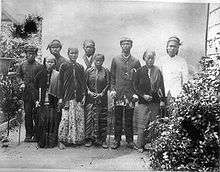
As a plantation colony, Suriname had an economy dependent on labor-intensive commodity crops. To make up for a shortage of labor, the Dutch recruited and transported contract or indentured laborer from the Dutch East Indies (modern Indonesia) and India (the latter through an arrangement with the British, who then ruled the area). In addition, during the late 19th and early 20th centuries, small numbers of laborers, mostly men, were recruited from China and the Middle East.
Although Suriname's population remains relatively small, because of this complex colonization and exploitation, it is one of the most ethnically and culturally diverse countries in the world.[23][24]
Decolonization
During World War II, on 23 November 1941, under an agreement with the Netherlands government-in-exile, the United States occupied Suriname to protect the bauxite mines to support the Allies' war effort.[25] In 1942, the Dutch government-in-exile began to review the relations between the Netherlands and its colonies in terms of the post-war period.
In 1954, Suriname became one of the constituent countries of the Kingdom of the Netherlands, along with the Netherlands Antilles and the Netherlands. In this construction, the Netherlands retained control of its defense and foreign affairs. In 1974, the local government, led by the National Party of Suriname (NPS) (whose membership was largely Creole, meaning ethnically African or mixed African-European) started negotiations with the Dutch government leading towards full independence, which was granted on 25 November 1975. A large part of Suriname's economy for the first decade following independence was fueled by foreign aid provided by the Dutch government.
Independence

The first President of the country was Johan Ferrier, the former governor, with Henck Arron (the then leader of the NPS) as Prime Minister. In the years leading up to independence, nearly one-third of the population of Suriname emigrated to the Netherlands, amidst concern that the new country would fare worse under independence than it had as a constituent country of the Kingdom of the Netherlands. Surinamese politics did degenerate into ethnic polarisation and corruption soon after independence, with the NPS using Dutch aid money for partisan purposes. Its leaders were accused of fraud in the 1977 elections, in which Arron won a further term, and the discontent was such that a large portion of the population fled to the Netherlands, joining the already significant Surinamese community there.[26]
1980 military coup
On 25 February 1980, a military coup overthrew Arron's government. It was initiated by a group of 16 sergeants, led by Dési Bouterse.[12] Opponents of the military regime attempted counter-coups in April 1980, August 1980, 15 March 1981, and again on 12 March 1982. The first counter attempt was led by Fred Ormskerk,[27] the second by Marxist-Leninists,[28] the third by Wilfred Hawker, and the fourth by Surendre Rambocus.
Hawker escaped from prison during the fourth counter-coup attempt, but he was captured and summarily executed. Between 2 am and 5 am on 7 December 1982, the military, under the leadership of Dési Bouterse, rounded up 13 prominent citizens who had criticized the military dictatorship and held them at Fort Zeelandia in Paramaribo.[29] The dictatorship had all these men executed over the next three days, along with Rambocus and Jiwansingh Sheombar (who was also involved in the fourth counter-coup attempt).
1987 elections and constitution
National elections were held in 1987. The National Assembly adopted a new constitution that allowed Bouterse to remain in charge of the army. Dissatisfied with the government, Bouterse summarily dismissed the ministers in 1990, by telephone. This event became popularly known as the "Telephone Coup". His power began to wane after the 1991 elections.
The brutal civil war between the Suriname army and Maroons loyal to rebel leader Ronnie Brunswijk, begun in 1986, continued and its effects further weakened Bouterse's position during the 1990s. Due to the civil war, more than 10,000 Surinamese, mostly Maroons, fled to French Guiana in the late 1980s.[30]
In 1999, the Netherlands tried Bouterse in absentia on drug smuggling charges. He was convicted and sentenced to prison but remained in Suriname.[31]
21st century
On 19 July 2010, the former dictator Dési Bouterse returned to power when he was elected as the new President of Suriname.[32] Before his election in 2010, he, along with 24 others, had been charged with the murders of 15 prominent dissidents in the December murders. However, in 2012, two months before the verdict in the trial, the National Assembly extended its amnesty law and provided Bouterse and the others with amnesty of these charges. He was reelected on 14 July 2015.[33] However, Bouterse was convicted by a Surinamese court on 29 November 2019 and given a 20-year sentence for his role in the 1982 killings.[34]
After winning the 2020 elections,[35] Chan Santokhi was the sole nomination for President of Suriname.[36] On 13 July, Santokhi was elected president by acclamation in an uncontested election.[37] He was inaugurated on 16 July in ceremony without public due to the COVID-19 pandemic.[38]
Politics

.jpg)
The Republic of Suriname is a representative democratic republic, based on the Constitution of 1987. The legislative branch of government consists of a 51-member unicameral National Assembly, simultaneously and popularly elected for a five-year term.
In the elections held on Tuesday, 25 May 2010, the Megacombinatie won 23 of the National Assembly seats followed by Nationale Front with 20 seats. A much smaller number, important for coalition-building, went to the "A‑combinatie" and to the Volksalliantie. The parties held negotiations to form coalitions. Elections were held on 25 May 2015, and the National Assembly again elected Desire Bouterse as president.[39]
The President of Suriname is elected for a five-year term by a two-thirds majority of the National Assembly. If at least two-thirds of the National Assembly cannot agree to vote for one presidential candidate, a People's Assembly is formed from all National Assembly delegates and regional and municipal representatives who were elected by popular vote in the most recent national election. The president may be elected by a majority of the People's Assembly called for the special election.
As head of government, the president appoints a sixteen-minister cabinet. A vice president, is normally elected for a five-year term at the same time as the president, by a simple majority in the National Assembly or People's Assembly. There is no constitutional provision for removal or replacement of the president, except in the case of resignation.
The judiciary is headed by the High Court of Justice of Suriname (Supreme Court). This court supervises the magistrate courts. Members are appointed for life by the president in consultation with the National Assembly, the State Advisory Council, and the National Order of Private Attorneys.
Foreign relations
President Dési Bouterse was convicted and sentenced in the Netherlands to 11 years of imprisonment for drug trafficking. He is the main suspect in the court case concerning the 'December murders,' the 1982 assassination of opponents of military rule in Fort Zeelandia, Paramaribo. These two cases still strain relations between the Netherlands and Suriname.[40]
Due to Suriname's Dutch colonial history, Suriname had a long-standing special relationship with the Netherlands. The Dutch government has stated that it will only maintain limited contact with the president.[40]
Bouterse was elected as president of Suriname in 2010. The Netherlands in July 2014 dropped Suriname as a member of its development program.[41]
Since 1991, the United States has maintained positive relations with Suriname. The two countries work together through the Caribbean Basin Security Initiative (CBSI) and the U.S. President's Emergency Plan for AIDS Relief (PEPFAR). Suriname also receives military funding from the U.S. Department of Defense.[42]
European Union relations and cooperation with Suriname are carried out both on a bilateral and a regional basis. There are ongoing EU-Community of Latin American and Caribbean States (CELAC) and EU-CARIFORUM dialogues. Suriname is party to the Cotonou Agreement, the partnership agreement among the members of the African, Caribbean and Pacific Group of States and the European Union.[43]
On 17 February 2005, the leaders of Barbados and Suriname signed the "Agreement for the deepening of bilateral cooperation between the Government of Barbados and the Government of the Republic of Suriname."[44] On 23–24 April 2009, both nations formed a Joint Commission in Paramaribo, Suriname, to improve relations and to expand into various areas of cooperation.[45] They held a second meeting toward this goal on 3–4 March 2011, in Dover, Barbados. Their representatives reviewed issues of agriculture, trade, investment, as well as international transport.[46]
In the late 2000s, Suriname intensified development cooperation with other developing countries. China's South-South cooperation with Suriname has included a number of large-scale infrastructure projects, including port rehabilitation and road construction. Brazil signed agreements to cooperate with Suriname in education, health, agriculture, and energy production.[47]
Military
The Armed Forces of Suriname have three branches: the Army, the Air Force, and the Navy. The President of the Republic, Chan Santokhi, is the Supreme Commander-in-Chief of the Armed Forces (Opperbevelhebber van de Strijdkrachten). The President is assisted by the Minister of Defence. Beneath the President and Minister of Defence is the Commander of the Armed Forces (Bevelhebber van de Strijdkrachten). The Military Branches and regional Military Commands report to the Commander.
After the creation of the Statute of the Kingdom of the Netherlands, the Royal Netherlands Army was entrusted with the defense of Suriname, while the defense of the Netherlands Antilles was the responsibility of the Royal Netherlands Navy. The army set up a separate Troepenmacht in Suriname (Forces in Suriname, TRIS). Upon independence in 1975, this force was turned into the Surinaamse Krijgsmacht (SKM):, Surinamese Armed Forces. On 25 February 1980, a group of 15 non-commissioned officers and one junior SKM officer, under the leadership of sergeant major Dési Bouterse, overthrew the Government. Subsequently, the SKM was rebranded as Nationaal Leger (NL), National Army.
In 1965 the Dutch and Americans used Suriname's Coronie site for multiple Nike Apache sounding rocket launches.[48]
Administrative divisions

The country is divided into ten administrative districts, each headed by a district commissioner appointed by the president, who also has the power of dismissal. Suriname is further subdivided into 62 resorts (ressorten).

| District | Capital | Area (km2) | Area (%) | Population (2012 census)[49] |
Population (%) | Pop. dens. (inhabitants/km2) | |
|---|---|---|---|---|---|---|---|
| 1 | Brokopondo | Brokopondo | 7,364 | 4.5 | 15,909 | 2.9 | 2.2 |
| 2 | Commewijne | Nieuw-Amsterdam | 2,353 | 1.4 | 31,420 | 5.8 | 13.4 |
| 3 | Coronie | Totness | 3,902 | 2.4 | 3,391 | 0.6 | 0.9 |
| 4 | Marowijne | Albina | 4,627 | 2.8 | 18,294 | 3.4 | 4.0 |
| 5 | Nickerie | Nieuw-Nickerie | 5,353 | 3.3 | 34,233 | 6.3 | 6.4 |
| 6 | Para | Onverwacht | 5,393 | 3.3 | 24,700 | 4.6 | 4.6 |
| 7 | Paramaribo | Paramaribo | 182 | 0.1 | 240,924 | 44.5 | 1323.8 |
| 8 | Saramacca | Groningen | 3,636 | 2.2 | 17,480 | 3.2 | 4.8 |
| 9 | Sipaliwini | none | 130,567 | 79.7 | 37,065 | 6.8 | 0.3 |
| 10 | Wanica | Lelydorp | 443 | 0.3 | 118,222 | 21.8 | 266.9 |
| SURINAME | Paramaribo | 163,820 | 100.0 | 541,638 | 100.0 | 3.3 |
Geography
.jpg)
.jpg)
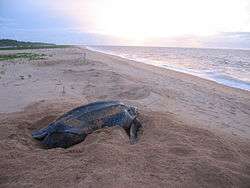
Suriname is the smallest independent country in South America. Situated on the Guiana Shield, it lies mostly between latitudes 1° and 6°N, and longitudes 54° and 58°W. The country can be divided into two main geographic regions. The northern, lowland coastal area (roughly above the line Albina-Paranam-Wageningen) has been cultivated, and most of the population lives here. The southern part consists of tropical rainforest and sparsely inhabited savanna along the border with Brazil, covering about 80% of Suriname's land surface.
The two main mountain ranges are the Bakhuys Mountains and the Van Asch Van Wijck Mountains. Julianatop is the highest mountain in the country at 1,286 metres (4,219 ft) above sea level. Other mountains include Tafelberg at 1,026 metres (3,366 ft), Mount Kasikasima at 718 metres (2,356 ft), Goliathberg at 358 metres (1,175 ft) and Voltzberg at 240 metres (790 ft).
Suriname's forest cover is 90.2%, the highest of any nation in the world.
Borders

Suriname is situated between French Guiana to the east and Guyana to the west. The southern border is shared with Brazil and the northern border is the Atlantic coast. The southernmost borders with French Guiana and Guyana are disputed by these countries along the Marowijne and Corantijn rivers, respectively, while a part of the disputed maritime boundary with Guyana was arbitrated by a tribunal convened under the rules set out in Annex VII of the United Nations Convention on the Law of the Sea on 20 September 2007.[50][51]
Climate
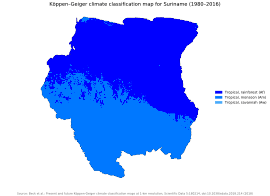
Lying 2 to 5 degrees north of the equator, Suriname has a very hot and wet tropical climate, and temperatures do not vary much throughout the year. Average relative humidity is between 80% and 90%. Its average temperature ranges from 29 to 34 degrees Celsius (84 to 93 degrees Fahrenheit). Due to the high humidity, actual temperatures are distorted and may therefore feel up to 6 degrees Celsius (11 degrees Fahrenheit) hotter than the recorded temperature. The year has two wet seasons, from April to August and from November to February. It also has two dry seasons, from August to November and February to April.
Climate change
Suriname is already seeing the effects of climate change, including warming temperatures and more extreme weather events. As a relatively poor country, its contributions to climate change have been limited; moreover, because of the large forest cover the country has been running a carbon-negative economy since 2014.[52]
Suriname was the second country to update its Nationally Determined Contributions in 2020.[53]Nature reserves
Located in the upper Coppename River watershed, the Central Suriname Nature Reserve has been designated a UNESCO World Heritage Site for its unspoiled forests and biodiversity. There are many national parks in the country including Galibi National Reserve along the coast; Brownsberg Nature Park and Eilerts de Haan Nature Park in central Suriname; and the Sipaliwani Nature Reserve on the Brazilian border. In all, 16% of the country's land area is national parks and lakes, according to the UNEP World Conservation Monitoring Centre.[54]
Economy

Suriname's democracy gained some strength after the turbulent 1990s, and its economy became more diversified and less dependent on Dutch financial assistance. Bauxite (aluminium ore) mining used to be a strong revenue source. The discovery and exploitation of oil and gold has added substantially to Suriname's economic independence. Agriculture, especially rice and bananas, remains a strong component of the economy, and ecotourism is providing new economic opportunities. More than 80% of Suriname's land-mass consists of unspoiled rain forest; with the establishment of the Central Suriname Nature Reserve in 1998, Suriname signalled its commitment to conservation of this precious resource. The Central Suriname Nature Reserve became a World Heritage Site in 2000.
The economy of Suriname was dominated by the bauxite industry, which accounted for more than 15% of GDP and 70% of export earnings up to 2016. Other main export products include rice, bananas and shrimp. Suriname has recently started exploiting some of its sizeable oil[55] and gold[56] reserves. About a quarter of the people work in the agricultural sector. The Surinamese economy is very dependent on commerce, its main trade partners being the Netherlands, the United States, Canada, and Caribbean countries, mainly Trinidad and Tobago and the islands of the former Netherlands Antilles.[57]
After assuming power in the fall of 1996, the Wijdenbosch government ended the structural adjustment program of the previous government, claiming it was unfair to the poorer elements of society. Tax revenues fell as old taxes lapsed and the government failed to implement new tax alternatives. By the end of 1997, the allocation of new Dutch development funds was frozen as Surinamese Government relations with the Netherlands deteriorated. Economic growth slowed in 1998, with decline in the mining, construction, and utility sectors. Rampant government expenditures, poor tax collection, a bloated civil service, and reduced foreign aid in 1999 contributed to the fiscal deficit, estimated at 11% of GDP. The government sought to cover this deficit through monetary expansion, which led to a dramatic increase in inflation. It takes longer on average to register a new business in Suriname than virtually any other country in the world (694 days or about 99 weeks).[58]
- GDP (2010 est.): U.S. $4.794 billion.
- Annual growth rate real GDP (2010 est.): 3.5%.
- Per capita GDP (2010 est.): U.S. $9,900.
- Inflation (2007): 6.4%.
- Natural resources: Bauxite, gold, oil, iron ore, other minerals; forests; hydroelectric potential; fish and shrimp.
- Agriculture: Products—rice, bananas, timber, palm kernels, coconuts, peanuts, citrus fruits, and forest products.
- Industry: Types—alumina, oil, gold, fish, shrimp, lumber.
- Trade:
- Exports (2012): $2.563 billion: alumina, gold, crude oil, lumber, shrimp and fish, rice, bananas. Major consumers: US 26.1%, Belgium 17.6%, UAE 12.1%, Canada 10.4%, Guyana 6.5%, France 5.6%, Barbados 4.7%.[12]
- Imports (2012): $1.782 billion: capital equipment, petroleum, foodstuffs, cotton, consumer goods. Major suppliers: US 25.8%, Netherlands 15.8%, China 9.8%, UAE 7.9%, Antigua and Barbuda 7.3%, Netherlands Antilles 5.4%, Japan 4.2%.[12]
Demographics
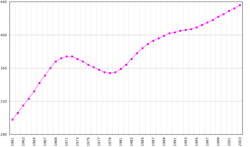
According to the 2012 census, Suriname had a population of 541,638 inhabitants.[5] The Surinamese populace is characterized by its high level of diversity, wherein no particular demographic group constitutes a majority. This is a legacy of centuries of Dutch rule, which entailed successive periods of forced, contracted, or voluntary migration by various nationalities and ethnic groups from around the world.
The largest ethnic group are the Afro-Surinamese which form about 37% of the population, and are usually divided into two groups: the Creoles and the Maroons. Surinamese Maroons, whose ancestors are mostly runaway slaves that fled to the interior, comprise 21.7% of the population; they are divided into six main groups: Ndyuka (Aucans), Saramaccans, Paramaccans, Kwinti, Aluku (Boni) and Matawai. Surinamese Creoles, mixed people descending from African slaves and mostly Dutch Europeans, form 15.7% of the population. East Indians, who form 27% of the population, are the second largest group. They are descendants of 19th-century contract workers from India, hailing mostly from the modern Indian states of Bihar, Jharkhand, and Eastern Uttar Pradesh along the Nepali border. Javanese make up 14% of the population, and like the East Indians, descend largely from workers contracted from the island of Java in the former Dutch East Indies (modern Indonesia).[59] 13.4% of the population identifies as being of mixed ethnic heritage.
Other sizeable groups include the Chinese, originating from 19th-century contract workers and some recent migration, who number over 40,000 as of 2011; Lebanese, primarily Maronites; Jews of Sephardic and Ashkenazi origin, whose center of population was the community of Jodensavanne; and Brazilians, many of them laborers mining for gold.[60]
A small but influential number of Europeans remain in the country, comprising about 1 percent of the population. They are descended mostly from Dutch 19th-century immigrant farmers, known as "Boeroes" (derived from boer, the Dutch word for "farmer"), and to a lesser degree other European groups, such as Portuguese from Madeira. Many Boeroes left after independence in 1975.
Various indigenous peoples make up 3.7% of the population, with the main groups being the Akurio, Arawak, Kalina (Caribs), Tiriyó and Wayana. They live mainly in the districts of Paramaribo, Wanica, Para, Marowijne and Sipaliwini.
The vast majority of Suriname's inhabitants (about 90%) live in Paramaribo or on the coast.
Emigration
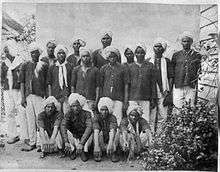
The choice of becoming Surinamese or Dutch citizens in the years leading up to Suriname's independence in 1975 led to a mass migration to the Netherlands. This migration continued in the period immediately after independence and during military rule in the 1980s and for largely economic reasons extended throughout the 1990s. The Surinamese community in the Netherlands numbered 350,300 as of 2013 (including children and grandchildren of Suriname migrants born in The Netherlands); this is compared to approximately 566,000[12] Surinamese in Suriname itself.
According to the International Organization for Migration, around 272,600 people from Suriname lived in other countries in the late 2010s, in particular in the Netherlands (ca 192,000), the French Republic (ca 25,000, most of them in French Guiana),[note 2] the United States (ca 15,000), Guyana (ca 5,000), Aruba (ca 1,500), and Canada (ca 1,000).[61]
Religion

Suriname's religious makeup is heterogeneous and reflective of the country's multicultural character.
According to the 2012 census, 48.4% were Christians;[7] 26.7% of Surinamese were Protestants (11.18% Pentecostal, 11.16% Moravian, and 4.4% of various other Protestant denominations) and 21.6% were Catholics. Hindus formed the second-largest religious group in Suriname, comprising 22.3% of the population,[7] the third largest proportion of any country in the Western Hemisphere after Guyana and Trinidad and Tobago, both of which also have large proportions of Indians. Almost all practitioners of Hinduism are found among the Indo-Surinamese population. Muslims constitute 13.9% of the population, the highest proportion of Muslims in the Americas; they are largely of Javanese or Indian descent.[7] Other religious groups include Winti (1.8%),[7] an Afro-American religion practiced mostly by those of Maroon ancestry; Javanism (0.8%),[7] a syncretic faith found among some Javanese Surinamese; and various indigenous folk traditions that are often incorporated into one of the larger religions (usually Christianity). In the 2012 census, 7.5% of the population declared they had "no religion", while a further 3.2% left the question unanswered.[7]
Languages
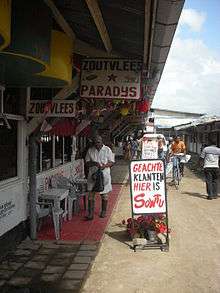
Dutch is the sole official language, and is the language of education, government, business, and the media.[12] Over 60% of the population speaks Dutch as a mother tongue,[62] and most of the rest speaks it as a second language. In 2004, Suriname became an associate member of the Dutch Language Union.[63] It is the only Dutch-speaking country in South America as well as the only independent nation in the Americas where Dutch is spoken by a majority of the population, and one of the two non-Romance-speaking countries in South America, the other being English-speaking Guyana.
In Paramaribo, Dutch is the main home language in two-thirds of the households.[4] The recognition of "Surinaams-Nederlands" ("Surinamese Dutch") as a national dialect equal to "Nederlands-Nederlands" ("Dutch Dutch") and "Vlaams-Nederlands" ("Flemish Dutch") was expressed in 2009 by the publication of the Woordenboek Surinaams Nederlands (Surinamese–Dutch Dictionary).[64] It is the most commonly spoken language in urban areas; only in the interior of Suriname (namely parts of Sipaliwini and Brokopondo) is Dutch seldom spoken.
Sranan Tongo, a local creole language originally spoken by the Creole population group, is the most widely used vernacular language in day-to-day life and business. It and Dutch are considered to be the two principal languages of Surinamese diglossia; both are further influenced by other spoken languages which are spoken primarily within ethnic communities. Sranan Tongo is often used interchangeably with Dutch depending on the formality of the setting, where Dutch is seen as a prestige dialect and Sranan Tongo the common vernacular.[65]
Caribbean Hindustani or Sarnami, a dialect of Bhojpuri, is the fourth-most used language (after English), spoken by the descendants of South Asian contract workers from then British India. The Javanese language is used by the descendants of Javanese contract workers, and is common in Suriname. The Maroon languages, somewhat intelligible with Sranan, include Saramaka, Paramakan, Ndyuka (also called Aukan), Kwinti and Matawai. Amerindian languages, spoken by Amerindians, include Carib and Arawak. Hakka and Cantonese are spoken by the descendants of the Chinese contract workers. Mandarin is spoken by some few recent Chinese immigrants. English, Spanish, and Portuguese are also used as second languages.
Largest cities
The national capital, Paramaribo, is by far the dominant urban area, accounting for nearly half of Suriname's population and most of its urban residents; indeed, its population is greater than the next nine largest cities combined. Most municipalities are located within the capital's metropolitan area, or along the densely populated coastline.
Culture
Owing to the country's multicultural heritage, Suriname celebrates a variety of distinct ethnic and religious festivals.
National holidays
- 1 January – New Year's Day
- 6 January – Three Kings Day
- January – World Religion Day
- January/February – Chinese New Year
- 25 February – Day of the Revolution
- March (varies) – Holi
- March/April – Good Friday
- March/April – Easter
- 1 May – Labour Day
- May/June – Ascension day
- 5 June – Indian Arrival Day
- 1 July – Keti Koti (Emancipation Day – end of slavery)
- 8 August – Javanese Arrival Day
- 9 August – Indigenous People's Day
- 10 October – Day of the Maroons
- 20 October – Chinese Arrival day
- October/November – Diwali
- 25 November – Independence Day
- 25 December – Christmas
- 26 December – Boxing Day
- varies - Eid-ul-adha
There are several Hindu and Islamic national holidays like Diwali (deepavali), Phagwa and Eid ul-Fitr and Eid-ul-adha. These holidays do not have fixed dates on the Gregorian calendar, as they are based on the Hindu and Islamic calendars, respectively. As of 2020, Eid-ul-adha is a national holiday, and equal to a Sunday.[67]
There are several holidays which are unique to Suriname. These include the Indian, Javanese and Chinese arrival days. They celebrate the arrival of the first ships with their respective immigrants.
New Year's Eve
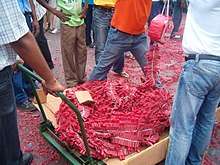
New Year's Eve in Suriname is called Oud jaar, Owru Yari, or "old year". It is during this period that the Surinamese population goes to the city's commercial district to watch "demonstrational fireworks". The bigger stores invest in these firecrackers and display them out in the streets. Every year the length of them is compared, and high praises are given for the company that has imported the largest ribbon.
These celebrations start at 10 in the morning and finish the next day. The day is usually filled with laughter, dance, music, and drinking. When the night starts, the big street parties are already at full capacity. The most popular fiesta is the one that is held at café 't Vat in the main tourist district. The parties there stop between 10 and 11 at night, after which people go home to light their pagaras (red-firecracker-ribbons) at midnight. After 12, the parties continue and the streets fill again until daybreak.[68]
Sports
The major sports in Suriname are football, basketball, and volleyball. The Suriname Olympic Committee is the national governing body for sports in Suriname. The major mind sports are chess, draughts, bridge and troefcall.
Many Suriname-born football players and Dutch-born football players of Surinamese descent, like Gerald Vanenburg, Ruud Gullit, Frank Rijkaard, Edgar Davids, Clarence Seedorf, Patrick Kluivert, Aron Winter, Georginio Wijnaldum, Virgil van Dijk and Jimmy Floyd Hasselbaink have turned out to play for the Dutch national team. In 1999, Humphrey Mijnals, who played for both Suriname and the Netherlands, was elected Surinamese footballer of the century.[69] Another famous player is André Kamperveen, who captained Suriname in the 1940s and was the first Surinamese to play professionally in the Netherlands.
The most famous international track & field athlete from Suriname is Letitia Vriesde, who won a silver medal at the 1995 World Championships behind Ana Quirot in the 800 metres, the first medal won by a South American female athlete in World Championship competition. In addition, she also won a bronze medal at the 2001 World Championships and won several medals in the 800 and 1500 metres at the Pan-American Games and Central American and Caribbean Games. Tommy Asinga also received acclaim for winning a bronze medal in the 800 metres at the 1991 Pan American Games.
Swimmer Anthony Nesty is the only Olympic medalist for Suriname. He won gold in the 100-meter butterfly at the 1988 Summer Olympics in Seoul and he won bronze in the same discipline at the 1992 Summer Olympics in Barcelona. Originally from Trinidad and Tobago, he now lives in Gainesville, Florida, and is the coach of the University of Florida, mainly coaching distance swimmers.
Cricket is popular in Suriname to some extent, influenced by its popularity in the Netherlands and in neighbouring Guyana. The Surinaamse Cricket Bond is an associate member of the International Cricket Council (ICC). Suriname and Argentina are the only ICC associates in South America, although Guyana is represented on the West Indies Cricket Board, a full member. The national cricket team was ranked 47th in the world and sixth in the ICC Americas region as of June 2014, and competes in the World Cricket League (WCL) and ICC Americas Championship. Iris Jharap, born in Paramaribo, played women's One Day International matches for the Dutch national side, the only Surinamese to do so.[70]
In the sport of badminton the local heroes are Virgil Soeroredjo & Mitchel Wongsodikromo and also Crystal Leefmans. All winning medals for Suriname at the Carebaco Caribbean Championships, the Central American and Caribbean Games (CACSO Games)[71] and also at the South American Games, better known as the ODESUR Games. Virgil Soeroredjo also participated for Suriname at the 2012 London Summer Olympics, only the second badminton player, after Oscar Brandon, for Suriname to achieve this.[72] Current National Champion Sören Opti was the third Surinamese badminton player to participate at the Summer Olympics in 2016.
Multiple time K-1 kickboxing world champions Ernesto Hoost and Remy Bonjasky were born in Suriname or are of Surinamese descent. Other kickboxing world champions include Rayen Simson, Melvin Manhoef, Tyrone Spong, Jairzinho Rozenstruik and Regian Eersel.
Suriname also has a national korfball team, with korfball being a Dutch sport. Vinkensport is also practised.
Transportation
Suriname, along with neighboring Guyana, is one of only two countries on the mainland South American continent that drive on the left, although many vehicles are left hand drive as well as right hand drive.[73] One explanation for this practice is that at the time of its colonization of Suriname, the Netherlands itself used left-hand traffic, also introducing the practice in the Dutch East Indies, now Indonesia.[74] Another is that Suriname was first colonized by the British, and for practical reasons, this was not changed when it came under Dutch administration.[75] Although the Netherlands converted to driving to the right at the end of the 18th century,[74] Suriname did not.
Air
Airlines with departures from Suriname:
Airlines with arrivals in Suriname:
- Caribbean Airlines (Trinidad & Tobago)
- Insel Air (Curaçao)
- KLM (Netherlands)
- Gol Transportes Aéreos (Brazil)
- Copa Airlines (Panama)
- Tui (Netherlands)
- Fly All Ways (Curaçao), Cuba (Havana), (Santiago de Cuba)
- Surinam Airways (SLM) (Aruba), Brazil (Belém), (Curaçao), Guyana (Georgetown), Netherlands (Amsterdam), Trinidad & Tobago (Port of Spain), & USA (Miami).
Other national companies with an air operator certification:
- Aero Club Suriname (ACS) – General Aviation Aeroclub
- Coronie Aero Farmers (CAF) – Agriculture Cropdusting
- Eagle Air Services (EAS) – Agriculture Cropdusting
- ERK Farms (ERK) – Agriculture Cropdusting
- Overeem Air Service (OAS) – General Aviation Charters
- Pegasus Air Service (PAS) – Helicopter Charters
- Suriname Air Force / Surinaamse Luchtmacht (SAF / LUMA) – Military Aviation Surinam Air Force
- Surinam Sky Farmers (SSF) – Agriculture Cropdusting
- Surinaamse Medische Zendings Vliegdienst (MAF – Mission Aviation Fellowship) – General Aviation Missionary
- Vortex Aviation Suriname (VAS) – General Aviation Maintenance & Flightschool
Health
The Global Burden of Disease Study provides an on-line data source for analyzing updated estimates of health for 359 diseases and injuries and 84 risk factors from 1990 to 2017 in most of the world's countries.[76] Comparing Suriname with other Caribbean nations show that in 2017 the age-standardized death rate for all causes was 793 (males 969, females 641) per 100,000, far below the 1219 of Haiti, somewhat below the 944 of Guyana but considerably above the 424 of Bermuda. In 1990 the death rate was 960 per 100,000. Life expectancy in 2017 was 72 years (males 69, females 75). The death rate for children < 5 years was 581 per 100,000 compared to 1308 in Haiti and 102 in Bermuda. In 1990 and 2017, leading causes of age-standardized death rates were cardiovascular disease, cancer and diabetes/chronic kidney disease.
Education
Education in Suriname is compulsory until the age of 12,[77] and the nation had a net primary enrollment rate of 94% in 2004.[78] Literacy is very common, particularly among men.[78] The main university in the country is the Anton de Kom University of Suriname.
From elementary school to high school there are 13 grades. The elementary school has six grades, middle school four grades and high school three grades. Students take a test in the end of elementary school to determine whether they will go to the MULO (secondary modern school) or a middle school of lower standards like LBO. Students from the elementary school wear a green shirt with jeans, while middle school students wear a blue shirt with jeans.
Students going from the second grade of middle school to the third grade have to choose between the business or science courses. This will determine what their major subjects will be. In order to go on to study math and physics, the student must have a total of 12 points. If the student has fewer points, he/she will go into the business courses or fail the grade.
Biodiversity
_Edit.jpg)
Due to the variety of habitats and temperatures, biodiversity in Suriname is considered high.[79] In October 2013, 16 international scientists researching the ecosystems during a three-week expedition in Suriname's Upper Palumeu River Watershed catalogued 1,378 species and found 60—including six frogs, one snake, and 11 fish—that may be previously unknown species.[80][81][82][83] According to the environmental non-profit Conservation International, which funded the expedition, Suriname's ample supply of fresh water is vital to the biodiversity and healthy ecosystems of the region.[84]
Snakewood (Brosimum guianense), a shrub-like tree, is native to this tropical region of the Americas. Customs in Suriname report that snakewood is often illegally exported to French Guiana, thought to be for the crafts industry.[85]
Environmental preservation
On 21 March 2013, Suriname's REDD+ Readiness Preparation Proposal (R-PP 2013) was approved by the member countries of the Participants Committee of the Forest Carbon Partnership Facility (FCPF).[86]
As in other parts of Central and South America, indigenous communities have increased their activism to protect their lands and preserve habitat. In March 2015, the "Trio and Wayana communities presented a declaration of cooperation to the National Assembly of Suriname that announces an indigenous conservation corridor spanning 72,000 square kilometers (27,799 square miles) of southern Suriname. The declaration, led by these indigenous communities and with the support of Conservation International (CI) and World Wildlife Fund (WWF) Guianas, comprises almost half of the total area of Suriname."[87] This area includes large forests and is considered "essential for the country's climate resilience, freshwater security, and green development strategy."[87]
Media
Traditionally, De Ware Tijd was the major newspaper of the country, but since the '90s Times of Suriname, De West and Dagblad Suriname have also been well-read newspapers; all publish primarily in Dutch.[88]
Suriname has twenty-four radio stations, most of them also broadcast through the Internet. There are twelve television sources: ABC (Ch. 4–1, 2), RBN (Ch. 5–1, 2), Rasonic TV (Ch. 7), STVS (Ch. 8–1, 2, 3, 4, 5, 6), Apintie (Ch. 10–1), ATV (Ch. 12–1, 2, 3, 4), Radika (Ch. 14), SCCN (Ch. 17–1, 2, 3), Pipel TV (Ch. 18–1, 2), Trishul (Ch. 20–1, 2, 3, 4), Garuda (Ch. 23–1, 2, 3), Sangeetmala (Ch. 26), Ch. 30, Ch. 31, Ch.32, Ch.38, SCTV (Ch. 45). Also listened to is mArt, a broadcaster from Amsterdam founded by people from Suriname. Kondreman is one of the popular cartoons in Suriname.
There are also three major news sites: Starnieuws, Suriname Herald and GFC Nieuws.
In 2012, Suriname was ranked joint 22nd with Japan in the worldwide Press Freedom Index by the organization Reporters Without Borders.[89] This was ahead of the US (47th), the UK (28th), and France (38th).
Tourism

Most tourists visit Suriname for the biodiversity of the Amazonian rain forests in the south of the country, which are noted for their flora and fauna. The Central Suriname Nature Reserve is the biggest and one of the most popular reserves, along with the Brownsberg Nature Park which overlooks the Brokopondo Reservoir, one of the largest man-made lakes in the world. In 2008, the Berg en Dal Eco & Cultural Resort opened in Brokopondo.[90] Tonka Island in the reservoir is home to a rustic eco-tourism project run by the Saramaccaner Maroons.[91] Pangi wraps and bowls made of calabashes are the two main products manufactured for tourists. The Maroons have learned that colorful and ornate pangis are popular with tourists.[92] Other popular decorative souvenirs are hand-carved purple-hardwood made into bowls, plates, canes, wooden boxes, and wall decors.
There are also many waterfalls throughout the country. Raleighvallen, or Raleigh Falls, is a 56,000-hectare (140,000-acre) nature reserve on the Coppename River, rich in bird life. Also are the Blanche Marie Falls on the Nickerie River and the Wonotobo Falls. Tafelberg Mountain in the centre of the country is surrounded by its own reserve – the Tafelberg Nature Reserve – around the source of the Saramacca River, as is the Voltzberg Nature Reserve further north on the Coppename River at Raleighvallen. In the interior are many Maroon and Amerindian villages, many of which have their own reserves that are generally open to visitors.
Suriname is one of the few countries in the world where at least one of each biome that the state possesses has been declared a wildlife reserve. Around 30% of the total land area of Suriname is protected by law as reserves.
Other attractions include plantations such as Laarwijk, which is situated along the Suriname River. This plantation can be reached only by boat via Domburg, in the north central Wanica District of Suriname.
Crime rates continue to rise in Paramaribo and armed robberies are not uncommon. According to the current U.S. Department of State Travel Advisory at the date of the 2018 report's publication, Suriname has been assessed as Level 1: exercise normal precautions.[93]
Landmarks

The Jules Wijdenbosch Bridge is a bridge over the river Suriname between Paramaribo and Meerzorg in the Commewijne district. The bridge was built during the tenure of President Jules Albert Wijdenbosch (1996–2000) and was completed in 2000. The bridge is 52 metres (171 ft) high, and 1,504 metres (4,934 ft) long. It connects Paramaribo with Commewijne, a connection which previously could only be made by ferry. The purpose of the bridge was to facilitate and promote the development of the eastern part of Suriname. The bridge consists of two lanes (one lane each way) and is not accessible to pedestrians.
The construction of the Sts. Peter and Paul Cathedral started on 13 January 1883. Before it became a cathedral it was a theatre. The theatre was built in 1809 and burned down in 1820.
Suriname is one of the few countries in the world where a synagogue is located next to a mosque.[94] The two buildings are located next to each other in the centre of Paramaribo and have been known to share a parking facility during their respective religious rites, should they happen to coincide with one another.
A relatively new landmark is the Hindu Arya Dewaker temple in the Johan Adolf Pengelstraat in Wanica, Paramaribo, which was inaugurated in 2001. A special characteristic of the temple is that it does not have images of the Hindu divinities, as they are forbidden in the Arya Samaj, the Hindu movement to which the people who built the temple belong. Instead, the building is covered by many texts derived from the Vedas and other Hindu scriptures. The beautiful architecture makes the temple a tourist attraction.
Notes
- Both French Guiana and Falkland Islands are less extensive and populous, but they are an overseas department and region of France and an overseas territory of the United Kingdom respectively.
- The International Organization for Migration made a confusion regarding the number of Surinamese migrants living in French Guiana. Their number is already included in the number for France (24,753 at the time of writing), as can be seen here: données complémentaires.
References
- Suriname: An Asian Immigrant and the Organic Creation of the Caribbean's Most Unique Fusion Culture, archived from the original on 20 February 2017, retrieved 19 July 2017
- "Censusstatistieken 2012" (PDF). Algemeen Bureau voor de Statistiek in Suriname (General Statistics Bureau of Suriname). p. 76. Archived from the original (PDF) on 29 June 2014.
- "The World Factbook – Central Intelligence Agency". cia.gov.
- Algemeen Bureau voor de Statistiek. "Geselecteerde Census variabelen per district (Census-profiel)" (PDF). ABS. Archived from the original (PDF) on 10 September 2008. Retrieved 24 July 2008.
- "Census statistieken 2012". Statistics-suriname.org. Archived from the original on 13 November 2014. Retrieved 13 July 2014.
- "Definitieve Resultaten (Vol I) Etniciteit". Presentatie Evaluatie Rapport CENSUS 8: 42.
- 2012 Suriname Census Definitive Results Archived 24 September 2015 at the Wayback Machine. Algemeen Bureau voor de Statistiek – Suriname.
- ""World Population prospects – Population division"". population.un.org. United Nations Department of Economic and Social Affairs, Population Division. Retrieved 9 November 2019.
- ""Overall total population" – World Population Prospects: The 2019 Revision" (xslx). population.un.org (custom data acquired via website). United Nations Department of Economic and Social Affairs, Population Division. Retrieved 9 November 2019.
- "Suriname". International Monetary Fund.
- "2019 Human Development Report" (PDF). United Nations Development Programme. 2019. Retrieved 9 December 2019.
- "Suriname". The World Factbook. Central Intelligence Agency. 2013. Retrieved 4 August 2013.
- "Suriname", The New Encyclopædia Britannica, Encyclopædia Britannica, Volume 5. Edition 15, Encyclopædia Britannica, 2002, p. 547
- Menon, P.K. (October 1978). "International Boundaries: A Case Study of the Guyana-Surinam Boundary". The International and Comparative Law Quarterly. 27 (4): 738–768. doi:10.1093/iclqaj/27.4.738. JSTOR 758476.
- Oudschans Dentz, F. (1919–1920). "De Naam Suriname". De West-Indische Gids. 1ste Jaarg (Tweede Deel): 13–17. JSTOR 41847495.CS1 maint: date format (link)
- Wilkie, Lieutenant-Colonel (1841). The United Service Journal and Naval and Military Magazine. p. 205.
Coming from the south we pass Surinam, the original name of which was Surryham, so called after Lord Surry, in the time of Charles II., and since corrupted to Surinam.
- Baynes, Thomas Spencer (1888). Encyclopædia Britannica: A Dictionary of Arts, Sciences, and General Literature, Volume XI (Ninth Edition—Popular Reprint ed.).
In 1614, the states of Holland granted to any Dutch citizen a four years' monopoly of any harbour or place of commerce which he might discover in that region (Guiana). The first settlement, however, in Suriname (in 1630) was made by an Englishman, whose name is still preserved by Marshall's Creek.
- Streissguth, Tom (2009). Suriname in Pictures. Twenty-First Century Books. pp. 23–. ISBN 978-1-57505-964-8.
- Boxer, C.R. (1990). The Dutch Seaborne Empire. Penguin. pp. 271–272. ISBN 978-0140136180.
- Simon M. Mentelle, "Extract of the Dutch Map Representing the Colony of Surinam", c.1777, Digital World Library via Library of Congress. Retrieved 26 May 2013
- Douma, Michael J. (2015). "The Lincoln Administration's Negotiations to Colonize African Americans in Dutch Suriname" (PDF). Civil War History. 61 (2): 111–137. doi:10.1353/cwh.2015.0037.
- "Suriname View Geschiedenis". 30 July 2020.
- "Suriname Country Profile". BBC. 14 September 2012.
- "Multicultural Netherlands". UC Berkeley. 2010. Archived from the original on 23 July 2012. Retrieved 13 August 2012.
- World War II Timeline. Faculty.virginia.edu. Retrieved 15 August 2012.
- Obituary "The Guardian", 24 January 2001.
- Roger Janssen (1 January 2011). In Search of a Path: An Analysis of the Foreign Policy of Suriname from 1975 to 1991. BRILL. pp. 60–. ISBN 978-90-04-25367-4.
- Betty Sedoc-Dahlberg. "Refugees from Suriname". Retrieved 26 August 2016.
- "Bouterse heeft Daal en Rambocus doodgeschoten". Network Star Suriname, Paramaribo, Suriname. 23 March 2012.
- "Panorama de la population immigrée en Guyane" (PDF). INSEE. Retrieved 2 February 2019.
- Neilan, Terence (17 July 1999). "World Briefing". The New York Times. Retrieved 1 May 2010.
- Suriname ex-strongman Bouterse back in power, In: BBC News, 19 July 2010
- Suriname's Bouterse Secures Second Presidential Term, Voice of America News, 14 July 2015
- The Associated Press (29 November 2019). "Suriname President Convicted in 1982 Killings". The New York Times. ISSN 0362-4331. Retrieved 1 December 2019.
- "VHP grote winnaar verkiezingen 25 mei 2020". GFC Nieuws (in Dutch). Retrieved 26 May 2020.
- "Breaking: NDP dient geen lijst in". Dagblad Suriname (in Dutch). Retrieved 8 July 2020.
- "Live blog: Verkiezing president en vicepresident Suriname". De Ware Tijd (in Dutch). Retrieved 13 July 2020.
- "Inauguratie nieuwe president van Suriname op Onafhankelijkheidsplein". Waterkant (in Dutch). Retrieved 13 July 2020.
- "Suriname: Government". The World Factbook. 2018. Retrieved 6 May 2018.
- "The Netherlands and Suriname are closely linked". MinBuZa.nl. 18 November 2011. Archived from the original on 14 July 2014. Retrieved 13 July 2014.
- "Holland to redefine relationship with Suriname". Jamaica Gleaner. 23 March 2011. Retrieved 13 July 2014.
- "Suriname". US Department of State. 3 September 2013. Retrieved 13 July 2014.
- "European Union – EEAS (European External Action Service) | EU Relations with Suriname". Europa (web portal). 19 June 2014. Retrieved 13 July 2014.
- "STATEMENT BY THE RIGHT HONOURABLE OWEN S. ARTHUR, PRIME MINISTER, BARBADOS, ON THE OCCASION OF THE SIGNING OF THE AGREEMENT FOR THE DEEPENING OF BILATERAL COOPERATION BETWEEN THE GOVERNMENT OF BARBADOS AND THE GOVERNMENT OF THE REPUBLIC OF SURINAME, 17 FEBRUARY 2005, PARAMARIBO, SURINAME". Caribbean Community (CARICOM). 17 February 2005. Archived from the original on 3 August 2012. Retrieved 6 March 2011.
- Agreement for the Suriname-Barbados Joint Commission. foreign.gov.bb. 13 March 2009
- "BGIS Media – Press Releases – Second Meeting of the Barbados/Suriname Joint Commission". Gisbarbados.gov.bb. Retrieved 13 July 2014.
- Erthal Abdenur, Adriana (2013). "South-South Cooperation in Suriname: New Prospects for Infrastructure Integration?" (PDF). Integration and Trade. 36 (17): 95–104. Archived from the original on 8 January 2014.CS1 maint: BOT: original-url status unknown (link)
- SURINAME, DISCOVER. "About Suriname | Discover Suriname". www.discover-suriname.com.
- "Suriname at GeoHive". Geohive.com. Retrieved 13 July 2014.
- Permanent Court of Arbitration – Guyana v. Suriname Archived 8 February 2013 at the Wayback Machine
- Award of the Tribunal Archived 2 January 2011 at the Wayback Machine. pca-cpa.org. Retrieved 15 August 2012.
- "Suriname's climate promise, for a sustainable future". UN News. 31 January 2020. Retrieved 7 June 2020.
- "Suriname's Second National Communication - In Progress | UNDP Climate Change Adaptation". www.adaptation-undp.org. Retrieved 7 June 2020.
- UNEP World Conservation Monitoring Centre World Databbase on Protected Areas Archived 4 August 2009 at the Wayback Machine
- Rigzone (3 January 2006). Staatsolie Launches Tender for 3 Offshore Blocks
- Cambior Development of the Gross Rosebel Mine in Suriname. cambior.com
- "Suriname – Foreign trade". Encyclopedia of the Nations. 2010. Retrieved 18 August 2012.
- The Economist, Pocket World in Figures, 2008 Edition, London: Profile Books
- (in Indonesian) Orang Jawa di Suriname (Javanese in Suriname), kompasiana (14 March 2011)
- "Violence erupts in Surinam Archived 2 January 2010 at the Wayback Machine". Radio Netherlands Worldwide. 26 December 2009.
- International Organization for Migration. "World Migration". Retrieved 3 February 2019.
- "Het Nederlandse taalgebied" (in Dutch). Nederlandse Taalunie. 2005. Retrieved 4 November 2008.
- (in Dutch) Nederlandse Taalunie. taalunieversum.org
- Prisma Woordenboek Surinaams Nederlands, edited by Renata de Bies, in cooperation with Willy Martin and Willy Smedts, ISBN 978-90-491-0054-4
- Romero, Simon (23 March 2008). "In Babel of Tongues, Suriname Seeks Itself". The New York Times.
- "Biggest Cities Suriname". www.geonames.org.
- "Eid-ul-Adha vrije dag". De Ware Tijd (in Dutch). Retrieved 25 July 2020.
- "A Sabbatical in Suriname – Fun Facts, Questions, Answers, Information". Funtrivia.com. 25 February 1980. Archived from the original on 22 September 2014. Retrieved 13 July 2014.
- "Het debuut van Humphrey Mijnals". Olympisch Stadion. Archived from the original on 21 September 2013.
- Iris Jharap player profile and statistics – ESPNcricinfo. Retrieved 1 December 2014.
- Het blijft bij één keer brons op Cacso | Radio Nederland Wereldomroep. Rnw.nl (27 September 2012). Retrieved 12 July 2013.
- Results And Medalists Archived 4 April 2013 at the Wayback Machine. London2012.com. Retrieved 12 July 2013.
- In Suriname's Rain Forests, A Fight Over Trees vs. Jobs, Anthony DePalma, The New York Times, 4 September 1995
- New Scientist, 25 December 1986 – 1 January 1987, page 18
- The Rule of the Road: An International Guide to History and Practice, Peter Kincaid, Greenwood Press, 1986, page 138
- "GBD Compare | IHME Viz Hub". vizhub.healthdata.org. Retrieved 5 May 2020.
- United Nations High Commissioner for Refugees. "The UN Refugee Agency". Unhcr.org. Archived from the original on 10 May 2011. Retrieved 28 March 2010.
- "United Nations Development Programme". Hdrstats.undp.org. Archived from the original on 18 August 2009. Retrieved 28 March 2010.
- "Suriname". inaturalist.org.
- Cocoa frog and lilliputian beetle among 60 new species found in Suriname. The Guardian (3 October 2013). Retrieved 7 October 2013.
- New species discovered in Surname's mountain rainforests. The Telegraph (2 October 2013). Retrieved 7 October 2013.
- Scientists discover scores of species in Suriname's 'Tropical Eden'. NBC News (7 October 2013). Retrieved 7 October 2013.
- New-Species Pictures: Cowboy Frog, Armored Catfish, More. National Geographic (1 January 2012). Retrieved 7 October 2013.
- Discover 60 New Species In Suriname. The Huffington Post (3 October 2013). Retrieved 7 October 2013.
- Law Compliance, and prevention, and control of illegal activities in the forest sector of Suriname, Maureen Playfair
- Suriname gets the nod for environment programme – News – Global Jamaica. Jamaica-gleaner.com (25 March 2013). Retrieved 12 July 2013.
- "Guardians of the Forest: Indigenous Peoples Take Action to Conserve Nearly Half of Suriname", 5 March 2015, Press Release, Conservation International. Retrieved 6 October 2016
- De Koninck, Marc; de Vries, Ellen (2008). K'ranti! De Surinaamse pers 1774–2008 (PDF). pp. 235–243.
- Press Freedom Index 2011–2012 – Reporters Without Borders Archived 3 March 2016 at the Wayback Machine. Reports Without Borders. Retrieved 15 August 2012.
- "Surinaamse Broedergemeente stapt in ecotoerisme". Reformatorisch Dagblad (in Dutch). Retrieved 15 May 2020.
- "Tonka-eiland Saramaccaans kennis-centrum en Eco-toeristisch paradijs". Tonka-Eiland. 2009. Archived from the original on 8 February 2013. Retrieved 2 October 2012.
- Brouns, Rachelle (February 2011). "People in the beating heart of the Amazon" (PDF). Radboud university Nijmegen. Archived from the original (PDF) on 17 January 2012. Retrieved 17 December 2011.CS1 maint: ref=harv (link)
- "OSAC". osac.gov. 2018.
- Down Suriname Way, a Tiny Community of Jews Endures, Tablet, 8 December 2014
Further reading
- Box, Ben, Footprint Focus Guide: Guyana, Guyane & Suriname, (Footprint Travel Guides, 2011)
- Counter, S. Allen and David L. Evans, I Sought My Brother: An Afro-American Reunion, Cambridge: MIT Press, 1981
- Dew, Edward M., The Trouble in Suriname, 1975–93, (Greenwood Press, 1994)
- Gimlette, John, Wild Coast: Travels on South America's Untamed Edge (Profile Books, 2011)
- McCarthy Sr., Terrence J., A Journey into Another World: Sojourn in Suriname, (Wheatmark Inc., 2010)
- Westoll, Adam, Surinam, (Old Street Publishing, 2009)
External links
- "Suriname". The World Factbook. Central Intelligence Agency.
- Suriname at UCB Libraries GovPubs.
- Suriname from the BBC News.
- Dictionaries of Suriname languages
- Suriname at Curlie


- Perry–Castañeda Library Map Collection
- Key Development Forecasts for Suriname from International Futures.
- Materials on Suriname in the Digital Library of the Caribbean (dLOC)
- Websites of the government, President and National Assembly
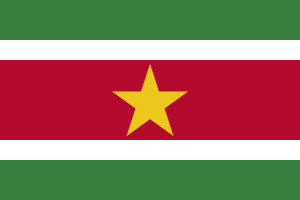
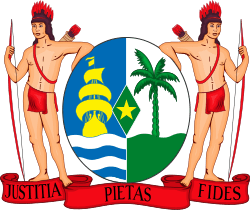
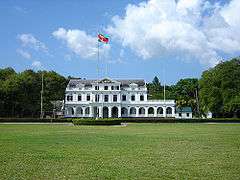
.svg.png)
